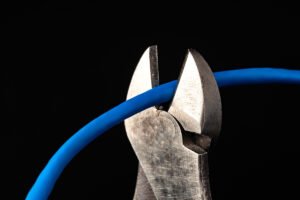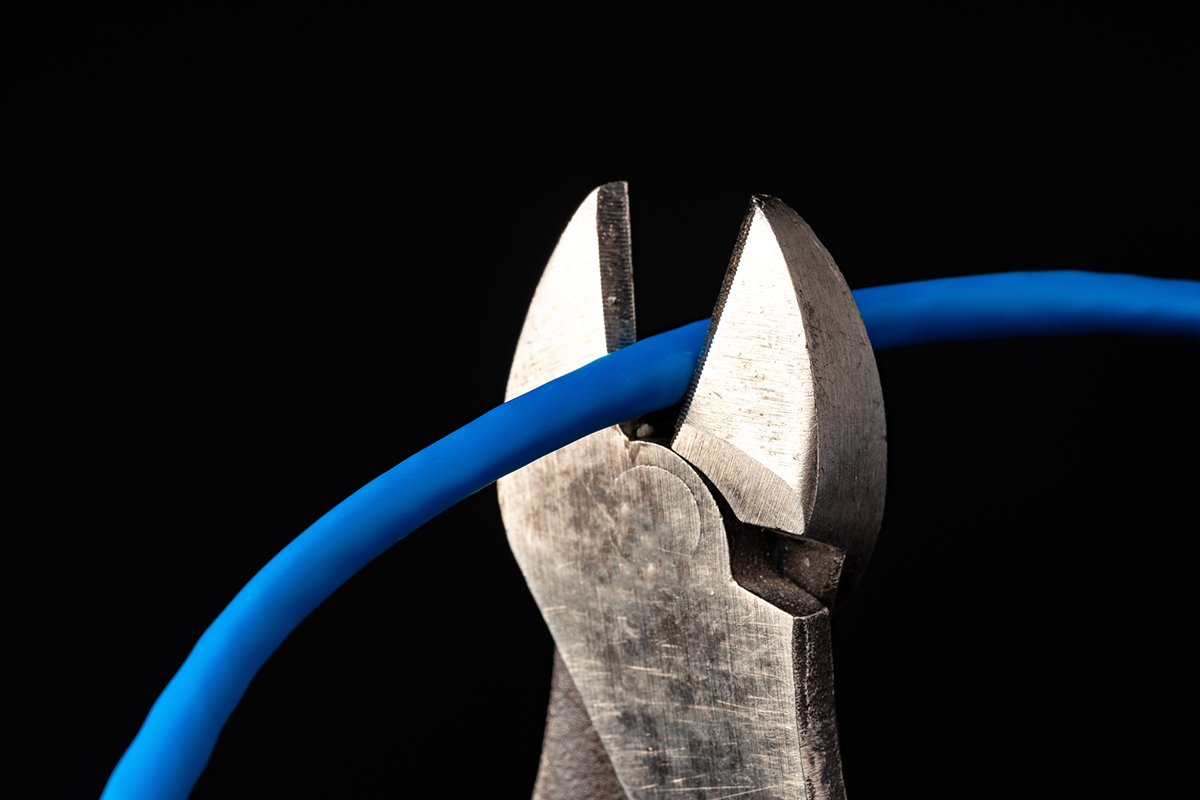
Editors’ note: This piece is from Nonprofit Quarterly Magazine’s summer 2024 issue, “Escaping Corporate Capture.”
The American media is a morbid affair as of late. Publications ranging from the Washington Post to the Wall Street Journal to the Intercept are laying off reporters by the droves.1 It’s a journalism Last Supper frag-a-thon every week. The sometimes nasty-as-its-name VICE is laying off hundreds, citing dwindling figures that conveniently overlook executives’ golden parachutes;2 Sports Illustrated said it was hanging up its swimsuits and jockstraps, and laid off most of its workforce.3 Welcome to the media extinction die-in.
We were always a precarious business, people like to say—and yes, in the 1990s, I fact-checked and peddled my own articles yet still ate my dinners off the crudité plates at book parties and lived close to the poverty line. The difference now is that it’s such a collective unwinding. Job losses have increased “by nearly 50 percent” in the media in 2023 alone, reports the Atlantic.4 A third of the newspapers that have been around 20 years or more will be gone a year from now, according to an Axios study.5 And in the meantime, billionaires are buying up media companies as hobbies.6
All of this has created profound uncertainty as well as an aroma of treachery. Which billionaire media owner will be trusted to stay the course? And how do we, the reporters and editors and readers, stay sane, solvent, resistant, and, yes, able to fund—and be funded toward—telling the truth?
There are four solutions—or “media harm reductions,” as I call them—that give me some hope: mutual aid, media co-ops, journalism nonprofits, and trauma care. Together, I think of them as a “dystopian social safety net.”7 I see this shadow safety net as America’s armature of smaller-scale solutions that support citizens and institutions when the formal or governmental ones have let us down. We should not have to rely on these support structures to survive—thankful as we may be that they are available; rather, they are fixes that shouldn’t have to exist but do, because our infrastructure is threadbare and our business sector is greedy.
Mutual Aid
The term mutual aid is over a century old.8 As the Center for Disaster Philanthropy’s Tanya Gulliver-Garcia put it, “At its most basic, mutual aid is the free or bartered exchange of goods between people. Its practitioners recognize that everyone has assets and needs.”9 It is a kind of interdependence, closer to altruism than to charity—a societal reciprocity. The Black Panther Party engaged in mutual aid: in 1969, members handed out breakfast to tens of thousands of public schoolchildren who would otherwise have gone hungry. Some “had never eaten breakfast before.”10 And during the COVID pandemic, mutual aids multiplied across the United States to ensure that elderly neighbors were fed and got their medicine.11
We should not have to rely on these support structures to survive—thankful as we may be that they are available; rather, they are fixes that shouldn’t have to exist but do, because our infrastructure is threadbare and our business sector is greedy.
A recent example of mutual aid as applied to journalism came about in 2022, when the Palm Beach Post, among other local newsrooms across the United States owned by the Gannett chain, was gutted by layoffs.12 In an interview, Kati Kokal, a Palm Beach Post reporter, described herself as feeling “helpless” when she received messages from colleagues who had been let go—so she put out what she called “random tweets”13 that said: “If you’re a @Gannett employee impacted by layoffs….DM me.”14 Immediately, 42 people wanted to donate—and thus was formed a mutual aid effort.15 People sent direct aid via Venmo, which included cash for things as granular as journalists’ medications and child care.16 Kokal started with a Google doc, in which those who were laid off could list their urgent needs, and another Google doc for those who wanted to donate money, time, or research to employees who had just been let go.17 The effort collected $10,000 dollars in emergency aid in six months, which they then distributed.18 They also connected those laid off with employment lawyers who could review their severance agreements and research unemployment in the reporters’ states.19 Inspired by Kokal, Emily Elena Dugdale started a similar mutual aid fund in 2024 for those who had been laid off by the Los Angeles Times.20
Media Co-ops
From farms and pizza parlors to ride-share services, worker co-ops—in which a company’s workers are also the owners—are on the rise in the United States. Worker co-ops emerged in the late 19th and early 20th centuries, predominantly in the Black community.21 The New Deal era, too, encouraged a shared work ethos—and a wave of collective businesses were named “self-help cooperatives”—a truer version of self-help than what we have today.22
And lately, worker cooperatives have been adopted by the media. A recent example is Flaming Hydra, a new media co-op described as an ad-free, subscription-based journalism cooperative.23 Flaming Hydra has 60 writers, who used to be described on its site as “on fire and hard to kill.”24 True to the flattened hierarchies of the workers cooperative or platform cooperativism, there’s no masthead; rather, there are members—some of whom readers may recognize from past bylines in other publications. Flaming Hydra was inspired by the historic rural electrical cooperatives of Ohio, of which members own a share.25 At Flaming Hydra, subscribers pay a monthly fee, and then that cumulative amount is split 60 ways by the contributors. As for the hierarchy, it’s flat. “A lot of the decision-making is made over Slack or over email threads,” said David Moore, a member of Flaming Hydra and its tech lead, as well as cofounder of the member site Sludge.26 “Everything is so crunched in the media now, that we saw Flaming Hydra as an opportunity to stretch out and to breathe with rad writing and rad folks.”27 Another recent media co-op is Brick House—which hosts Flaming Hydra and dates back to 2020, when it was founded as a democratically formed media group.28 And there are others: Hell Gate,29 Defector,30 Ground Zero: Aftermath!,31 404 Media,32 and the Appeal,33 to name a few.
Sign up for our free newsletters
Subscribe to NPQ's newsletters to have our top stories delivered directly to your inbox.
By signing up, you agree to our privacy policy and terms of use, and to receive messages from NPQ and our partners.
Journalism Nonprofits
We need this kind of independent journalism—not one functioning at the behest of billionaires, venture capitalists, and private equity.
Journalism nonprofits are another bridge—if not to a flourishing new journalism then at least to one that survives. I run one—the Economic Hardship Reporting Project, which was founded more than a decade ago.34 It started as journalist Barbara Ehrenreich’s idea, in response to the 2008 recession and ensuing wave of media layoffs.35 Back then, nonprofit journalism tended to mean NPR and PBS, or nascent media nonprofits like ProPublica. In the years that followed, there has been an exponential rise of media nonprofits. In the United States, many of these groups are local reporting outfits that arose in response to the stripping of the news media in rural areas and smaller towns. EHRP has partnered with many of them—Arizona Luminaria,36 Barn Raiser,37 New York Focus,38 and Flatwater Free Press.39 In our case, EHRP covers a certain population rather than a locality—independent reporters, many of whom are financially struggling, receive grants to report on inequality and poverty. The resulting articles are then copublished in mainstream publications. (Sometimes, the reporters are reporting on their own struggles.) Other new standout nonprofits whose ambit is, like ours, a population rather than a place, include the Prison Journalism Project, which trains and publishes incarcerated reporters.40
Trauma Care
The fourth form of media harm reduction for a media in free fall might sound a little Gen-Z snowflakey, but bear with me: it’s trauma care (or emotional support) for reporters who are dealing with uncertain professional and economic prospects as well as growing societal antagonism. To address this, we at EHRP have been looking into offering spaces where reporters can have honest conversations about their own conditions. Journalists undergoing this moment of extinction need therapy or its more casual cousins: peer support and moral support. EHRP is not the only organization that is considering offering such services. New York’s Dart Center41 and Puerto Rico’s Centro de Periodismo Investigativo,42 for example, have been providing trauma care to reporters for years.
A trauma-care harm-reduction method isn’t the easiest sell: reporters tend not to separate their work from their core selves. It’s our déformation professionelle: any professional setback can easily become a referendum on one’s personhood.43 Over the years, I have heard echoes of these feelings from EHRP contributors, who have written of the pain of being unceremoniously laid off in later middle age.44 But that’s part of what makes it so necessary. I am thinking also of help along the lines of the Gannett mutual aid’s moral support network, whose activities included letters of encouragement from people who still worked for Gannett to the laid-off reporters who no longer had a paycheck or a byline. One thing that Kati Kokal hoped reporters would gain from the mutual aid effort was knowing that although a layoff might be one of the worst experiences they’d ever had, at least they wouldn’t have to go through it alone.45
The Way Forward
As I write this, a new bill has been passed in New York State, the “Local Journalism Sustainability Act”—which, as the News Guild reports, will provide “tax credits to consumers for subscriptions to local news outlets and to news organizations for the employment of local news journalists.”46 This is a promising direction. I can also imagine a future in which a good deal of local reporting is done by citizens who have been taught to tell stories about their own communities, rather than by professional journalists. And I can imagine the broadening of the practice of holding live journalistic events that are themselves a form of reporting. Across the country, these could transpire in local bars and offices where information that is hyperlocal is shared in real time. We need this kind of independent journalism—not one functioning at the behest of billionaires, venture capitalists, and private equity—so that readers can better understand what is actually happening in their local statehouses and community board meetings and what is happening globally.
As journalism struggles to survive, enormously rich owners behave like neglectful parents—often ultimately disowning the very news entities they’ve helped to prop up for years. We need to liberate ourselves from this corporate capture if we are to survive, and that rests on a shift in mindset: a recognition that good media is unlikely to be for-profit media.
Notes
- Sam Becker, “News and media layoffs keep piling up after one of the worst years since the financial crisis,” Fast Company, February 23, 2024, fastcompany.com/91035879/news-media-layoffs-2024-list-growing-worst-year-financial-crisis; and Katie Robertson, “The Washington Post to Cut 240 Jobs,” New York Times, October 10, 2023, www.nytimes.com/2023/10/10/business/media/washington-post-job-cuts.html.
- “Vice Media says ‘several hundred’ staff members will be laid off and com news site shuttered,” Associated Press, February 22, 2024, apnews.com/article/vice-media-layoffs-bruce-dixon-3439e54142c8 8530a5825642a81aeec5; and Joseph Cox (@josephfcox), “Today at VICE I was unable to pull a court record, which costs 10 cents, because the company isn’t paying bills. Meanwhile so many execs, some which led VICE to bankruptcy, make $700-900k,” Twitter, July 10, 2023, 8:36 p.m., twitter.com/josephfcox/status/1678563799157096448.
- Although now it appears the magazine could be getting a new start with a different See Nicole Kraft, “Mass Layoff Appears To Be The End Of Sports Illustrated,” Forbes, January 21, 2024, www.forbes.com/sites/nicolekraft/2024/01/21/mass-layoff-appears-to-be-the-end-of-sports-illustrated/; and Oliver Darcy and Liam Reilly, “Sports Illustrated to avert shutdown as it gets a fresh start under new publisher,” CNN, last modified March 18, 2024, www.cnn.com/2024/03/18/media/sports-illustrated-new-publisher/index.html.
- Paul Farhi, “Is American Journalism Headed Toward an ‘Extinction-Level Event’?,” The Atlantic, January 30, 2024, theatlantic.com/ideas/archive/2024/01/media-layoffs-la-times/677285/.
- Sara Fischer, “One-third of S. newspapers as of 2005 will be gone by 2024,” Axios, last modified November 16, 2023, www.axios.com/2023/11/16/newspapers-decline-hedge-funds-research.
- Rupert Neate, “‘Extra level of power’: billionaires who have bought up the media,” The Guardian, May 3, 2022, theguardian.com/news/2022/may/03/billionaires-extra-power-media-ownership-elon-musk.
- Alissa Quart, Bootstrapped: Liberating Ourselves from the American Dream (New York: Ecco/HarperCollins, 2023), 218–21.
- See Peter Kropotkin, 1910 essay, “The Theory of Evolution and Mutual Aid”; and Pëtr Kropotkin, Mutual Aid: A Factor of Evolution (1902), The Anarchist Library, retrieved February 16, 2009, from pitzer.edu, theanarchistlibrary.org/library/petr-kropotkin-mutual-aid-a-factor-of-evolution.
- Tanya Gulliver-Garcia, “The Growing Role of Mutual Aid,” NPQ, May 1, 2022, nonprofitquarterly.org/the-growing-role-of-mutual-aid/.
- Quart, Bootstrapped, And see Erin Blakemore, “How the Black Panthers’ Breakfast Program Both Inspired and Threatened the Government,” History, last modified January 29, 2021, www.history.com/news/free-school-breakfast-black-panther-party
- See Alissa Quart, “The Feeling Is Mutual Aid,” in Bootstrapped, 165–76.
- Angela Fu, “Gannett lays off roughly 400 staff after dismal second-quarter results,” Poynter, last modified September 1, 2022, poynter.org/business-work/2022/gannett-lays-off-journalists-after-dismal-second-quarter-results/. See also Joe Capozzi, “The future of The Palm Beach Post,” Power Poll, June 30, 2023, www.powerpoll.com/fl/palmbeach/articles/the-future-of-the-palm-beach-post-2114.
- Author interview with Kati Kokal, March 21,
- Kati Kokal (@katikokal), “If you’re a @Gannett employee impacted by layoffs, there is a team that’s working on community aid needs (networking, food assistance, insurance needs, etc) regardless of shop union DM me for details,” Twitter, August 12, 2022, 12:42 p.m., twitter.com/katikokal/status/1558131780338728966.
- Kati Kokal (@katikokal), “286. That’s the number of years of combined experience that the people @ Gannett laid off last week had at this company. And that’s only amongst the 42 people who have requested mutual aid so far,” Twitter, December 15, 2022, 7:27 a.m., twitter.com/katikokal/status/1599742130129408001. And see Omar Gallaga, “She started an aid network for laid-off journalists and it spread like wildfire,” Poynter, May 25, 2023, www.poynter.org/reporting-editing/2023/journalism-mutual-aid-network-layoffs-help/.
- Kati Kokal (@katikokal), “If you’d like to contribute, we’re still distributing funds to those who need help! Here’s the Venmo Last four digits of the phone number are 4170,” Twitter, December 14, 2022, 11:22 a.m., twitter.com/katikokal/status/1603062949060530178; and Gallaga, “She started an aid network for laid-off journalists and it spread like wildfire.”
- Gallaga, “She started an aid network for laid-off journalists and it spread like ”
- Camelia Heins, “How journalists can incorporate mutual aid to support one another and their communities,” International Journalists’ Network, March 20, 2024, ijnet.org/en/story/how-journalists-can-incorporate-mutual-aid-support-one-another-and-their-communities.
- Paul Bowers, “How to survive the news industry: Q&A with Kati Kokal, Florida education reporter and mutual aid organizer,” Brutal South, December 7, 2022, substack.com/p/how-to-survive-the-news-industry.
- Kristen Hare, “Here’s how to help laid off journalists in Los Angeles,” Poynter, January 25, 2024, www.poynter.org/business-work/2024/heres-how-to-help-laid-off-journalists-in-los-angeles/.
- Quart, Bootstrapped, 186–87. And see E. Burghardt Du Bois, ed., Economic Co-Operation Among Negro Americans (Atlanta, GA: Atlanta University Press, 1907).
- Quart, Bootstrapped,
- See Flaming Hydra, accessed April 21, 2024, flaminghydra.com; and Flaming Hydra, “About Us,” accessed April 21, 2024, flaminghydra.com/about/.
- See Luke O’Neil, “Is it really so strange?,” Welcome to Hell World, February 2, 2024, www.welcometohellworld.com/is-it-really-so-strange/.
- Author interview with Flaming Hydra–member David Moore, March
- Ibid.
- Ibid.
- The Brick House, accessed April 21, 2024, house.
- Hell Gate, accessed April 21, 2024, com.
- Defector, “About Us,” accessed April 21, 2024, com/about-us.
- Ground Zero: Aftermath!, accessed April 21, 2024, media.
- See Samantha Cole, “Overhyped Tech and Valuing Journalism,” Behind the Blog (blog), 404 Media, April 19, 2024, www.404media.co/behind-the-blog-overhyped-tech-and-valuing-journalism/.
- The Appeal, “About Us,” accessed April 21, 2024, org/about-us/.
- See Rithika Ramamurthy, “Amidst Mass Layoffs, Media Workers Tell a Different Story about Economic Decline,” NPQ, December 20, 2023, nonprofitquarterly.org/amidst-mass-layoffs-media-workers-tell-a-different-story-about-economic-decline/.
- For more information on my organization’s history, see Economic Hardship Reporting Project, “About,” accessed April 21, 2024, economichardship.org/about-ehrp/. (We incorporated in 2012, but organizing efforts began during the Great Recession.)
- Arizona Luminaria, “About us,” accessed April 21, 2024, azluminaria.org/about-us/.
- Barn Raiser, accessed April 21, 2024, barnraisingmedia.com.
- New York Focus, accessed April 21, 2024, nycfocus.com.
- Flatwater Free Press, accessed April 21, 2024, flatwaterfreepress.org.
- Prison Journalism Project, accessed April 21, 2024, prisonjournalismproject.org/.
- “A Dart Center program training therapists to help ,” Journalist Trauma Support Network, accessed April 13, 2024, www.jtsn.org.
- Centro de Periodismo Investigativo, accessed April 21, 2024, periodismoinvestigate.com/.
- See Hilary Davis, “Déformation Professionnelle,” In The Library With The Lead Pipe, March 17, 2010, www.inthelibrarywiththeleadpipe.org/2010/deformation-professionnelle/.
- Ray Suarez, “Sinking feeling,” Washington Post, April 30, 2020, washingtonpost.com/outlook/2020/04/30/i-clung-middle-class-i-aged-pandemic-pulled-me-under/.
- See the mutual aid network site: “Welcome to the community aid network: Mutual aid for journalists who have been laid off,” accessed April 21, 2024, journalismcommunityaid.wordpress.com.
- “New York legislature passes historic journalism jobs tax credit,” NewsGuild (TNG-CWA), April 20, 2024, newsguild.org/new-york-legislature-passes-historic-journalism-jobs-tax-credit/. For the text of the bill, see “A02958 Summary,” accessed April 2, 2024, gov/leg/?default_fld=&leg_video=&bn=A02958&term=2023&Summary=Y&Memo=Y&Text=Y.











